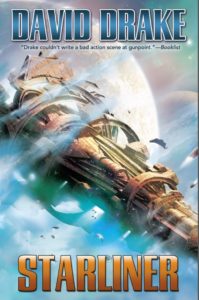2017 update: Baen brought out my 1992 Starliner as a trade paperback with a new cover by Dominic Harman. This was a book I wrote for myself–it was one of my frequent attempts to get noticed as something besides a Military SF writer–but it was also the solo book of mine in which Jim Baen was most heavily involved.
Listen to Dave’s interview about Starliner at The Baen Free Radio Hour.
Posted December 2000
 STARLINER is a book I wrote for myself. It isn’t exactly that Jim Baen didn’t want it, but he sure didn’t want it as much as he wanted another Hammer volume from me.
STARLINER is a book I wrote for myself. It isn’t exactly that Jim Baen didn’t want it, but he sure didn’t want it as much as he wanted another Hammer volume from me.
I’m best known–at least I was before I started writing the Isles series–for my military SF, but that’s never been more than about a quarter of my output. (The fraction looks much higher because of the covers publishers put on my books; see my comments on Northworld for a striking example of this.) Jim let me do what I wanted this time, knowing that the next book would be the one he was after. (This is a paradigm of our relationship over decades, and an example of why we have a decades-long relationship.)
I conceived Starliner as classic space opera, a longer version of a typical novella from Startling Stories or even Astounding during the 1940s. I’ve always been fascinated by ocean liners, so I used the superliner Normandie of 1938 as the template for my starship. (I have no idea why ocean liners fascinate me; with some people it’s trains, but for me it’s liners.)
I did a lot of research before writing Starliner, but to be completely honest the book was an excuse to use the research rather than the other way around. To a greater or lesser extent, that’s true of almost everything I write. It’s also a major reason that I’m so happy to be a writer as opposed to any of the other things I’ve done for money: every part of the job except the business negotiations and keying in the first-stage editing changes is fun.
The Cold Crews, working in Hell on a starship’s exterior, were modeled on the stokers of coal-fired steamships. People who (rightly) note how cramped and unpleasant ocean travel was for the immigrants in 3d Class (or 4th, in some vessels) generally forget that the ship’s Black Gang made the voyages in conditions worse by an order of magnitude. They did backbreaking labor in temperatures well over a hundred degrees, the boiler rooms lighted only by the flaming maws of the fireboxes and the atmosphere dulled by steam which escaped from every fitting.
Even on the smoothest of voyages, injuries were common. In a storm, while the ship rolled and the boiler room decks sloshed with sea water, the engines still had to be kept running if the ship and all aboard her were to survive. Men fell into machinery or the fires, but the boilers were fed regardless.
When stokers fought, the officers locked the boiler room hatches and let the men come to their own conclusions with coal shovels and clinker bars. There was no punishment that was worse than a normal day’s work in the Black Gang.
There’s a romance of sorts in people who do jobs worse than any sanction they could be threatened with for refusing. Kipling caught that attitude well a number of times–listen to the trolley horse speaking in A Walking Delegate, for example. It’s not moonlight on the promenade deck, but it affected me. I hope at least a little of what I’m talking about comes through to readers of Starliner.
My viewpoint character is a young man who likes women and who–because he doesn’t understand women at all–treats them the way he’d like to be treated himself. By so doing he wrecks lives with complete innocence.
I only mention this because occasionally I’m accused of being ignorant of the negative side of characters I’ve drawn as so job-focused that they take personal relationships at face value–and trivial. (Ritter in Northworld: Vengeance has a similar attitude.) No, I’m quite aware of what I’m saying, as surely as I am when I describe reconnaissance by fire–shooting into a clump of trees that might hold a sniper; or an old woman digging roots, of course.
Most of the incidents in Starliner are based on things that have really happened to somebody, somewhere; again, that’s true of most of my fiction. I didn’t invent Wade and Belgeddes, but neither did I personally know the guy on whom they were based. Was the story about him true? Damned if I know.
A few readers have picked up on the fact that snatches of the racist song in the first chapter is based on a real one sung by US troops in the Philippines during Taft’s term of office. (The original can be found either as The Carabao Song or Damn the Filipinos.) “Underneath the starry flag we’ll civilize them with a Krag [that is, a Krag-Jorgenson rifle].” I wish politicians would keep past human experience in mind when they discuss using soldiers to bring peace and civilization to troubled regions….
Starliner was fun to write. It didn’t sell as well as another Hammer book might’ve done, but it did all right. I’m glad I wrote it and still more glad that Jim let me write it.
—Dave Drake
